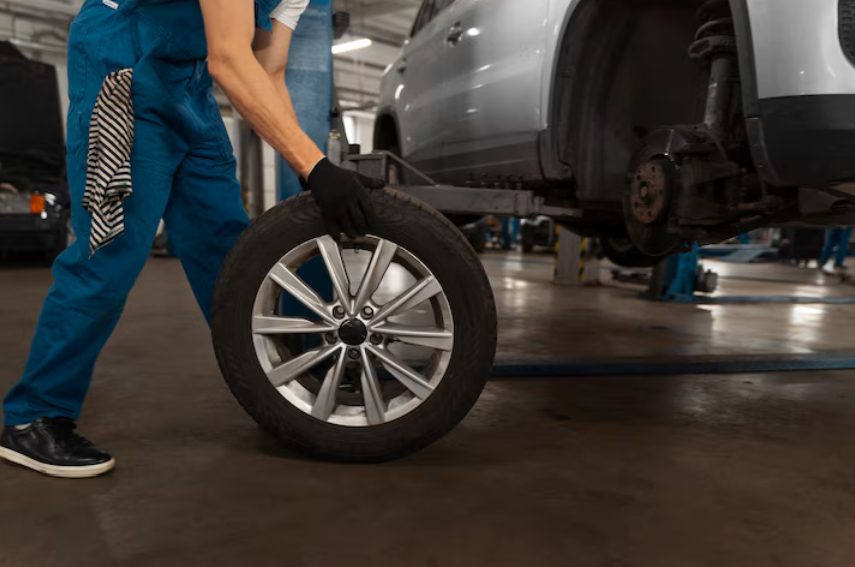 When we think about vehicle maintenance, we often focus on the big-ticket items—engine performance, brakes, or tyre replacements. But one of the most overlooked components of a smooth, safe driving experience is wheel balance. While your car might seem fine, it could be dealing with minor imbalances that gradually impact performance and safety. During routine car service Dandenong, wheel balancing is one essential check that can significantly enhance your driving experience.
When we think about vehicle maintenance, we often focus on the big-ticket items—engine performance, brakes, or tyre replacements. But one of the most overlooked components of a smooth, safe driving experience is wheel balance. While your car might seem fine, it could be dealing with minor imbalances that gradually impact performance and safety. During routine car service Dandenong, wheel balancing is one essential check that can significantly enhance your driving experience.
Even a small imbalance can lead to big problems. It’s what your car feels every day—but you might not.
The Domino Effect of Unbalanced Wheels
What begins as a subtle vibration—often mistaken for rough roads—can quietly develop into a larger issue. Unbalanced wheels mean the weight of the tyre and wheel assembly isn’t evenly distributed, causing a ripple effect throughout your vehicle.
This imbalance leads to uneven tyre wear, reducing the lifespan of your tyres and affecting grip and handling. Your engine may need to work harder to compensate, leading to reduced fuel efficiency. Meanwhile, suspension and steering components absorb constant vibration, which accelerates wear and tear. And, of course, your ride comfort takes a hit, making once-smooth drives feel bumpy and harsh.
More importantly, these seemingly minor issues can escalate into safety risks. If left unaddressed, unbalanced wheels could lead to a failed roadworthy certificate Dandenong, particularly if uneven tyre wear or suspension faults are flagged during inspection.
Wheel imbalance doesn’t always announce itself loudly, but your car will give you subtle hints if something’s not right. Common signs include:
- Vibrations in the steering wheel or seat, especially at speeds above 80 km/h
- Uneven or accelerated tyre wear, sometimes on just one side
- A slight pull or wobble in the steering
- A humming or buzzing sound coming from the tyres
- A noticeable decline in ride comfort or smoothness
While these symptoms might seem mild at first, they often point to underlying balance issues that only worsen over time.
What Causes Wheels to Fall Out of Balance?
Wheel imbalance is often the result of everyday driving and isn’t necessarily caused by poor driving habits. Several factors can trigger imbalance, such as:
- Tyre wear over time, which can alter weight distribution
- Hitting potholes or kerbs, which may dislodge balance weights
- Improper tyre installation without rebalancing
- Manufacturing defects in the tyre or wheel
- Build-up of dirt or debris on the rim or inside the wheel
Even brand-new tyres can become unbalanced if they’re not fitted correctly. That’s why proper installation and post-fitting balancing are so important.
Smart Practices to Maintain Wheel Balance
Maintaining wheel balance isn’t complicated, but it does require a proactive approach. Here are some simple steps that help:
- Rotate your tyres regularly, ideally every 10,000 to 15,000 kilometres
- Avoid road hazards like potholes and uneven surfaces where possible
- Check and maintain correct tyre pressure
- Clean your wheels periodically to remove mud or debris
- Have your wheels balanced whenever new tyres are fitted
By including wheel balancing as part of your vehicle’s maintenance plan, you reduce the chances of long-term issues developing.
When and How Often Should You Balance Your Wheels?
There’s no universal rule for wheel balancing, but certain situations call for it. You should consider balancing your wheels:
- When new tyres are installed
- After hitting a pothole or kerb
- If you notice vibration, unusual tyre wear, or changes in handling
- Every 10,000 to 15,000 kilometres as a general preventative measure
Balancing doesn’t take long and is typically inexpensive. Yet the results—better handling, reduced wear, and improved comfort—can be felt almost immediately.
How Balancing Affects Safety and Saves Money
Aside from delivering a smoother ride, properly balanced wheels have a direct impact on safety. They allow your tyres to maintain better contact with the road, improving control and reducing the risk of accidents—especially in emergency braking situations.
Financially, balanced wheels mean you’ll go through fewer tyres, avoid premature suspension repairs, and enjoy better fuel economy. All these benefits make it a small service that delivers serious long-term value.
Alignment Matters Too
While balancing corrects the weight distribution of the wheels, wheel alignment focuses on the angle and direction of the tyres. Misaligned wheels can lead to similar problems—uneven wear, poor handling, and added strain on your suspension.
If you’re getting your wheels balanced, it’s a good idea to also check the wheel alignment Dandenong. Ensuring both aspects are in sync helps maintain vehicle safety and performance, especially over long distances or frequent driving.
Wheel balance is something your vehicle constantly reacts to, even if you don’t notice it right away. From steering response to fuel efficiency and tyre longevity, it plays a vital role in how your car feels and performs.
Whether you’re noticing symptoms or just due for a check, don’t wait until the imbalance causes bigger problems. For expert wheel balancing, alignment, and complete vehicle care, contact Continental Dandenong. Call us today on 03 9791 8841 to book your next service and keep your wheels rolling smoothly.
